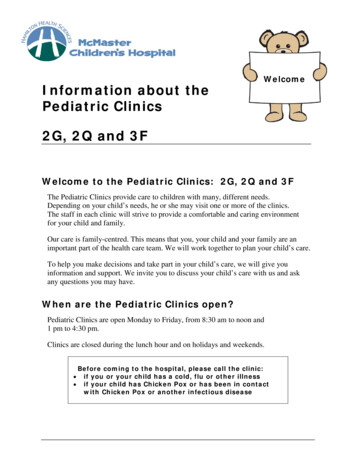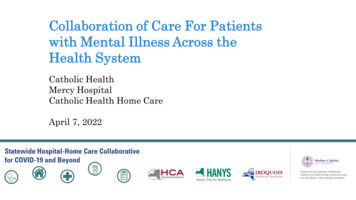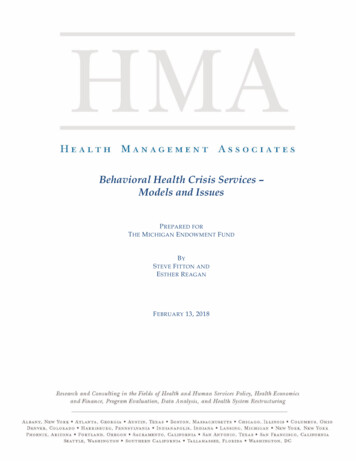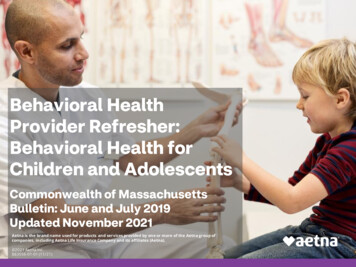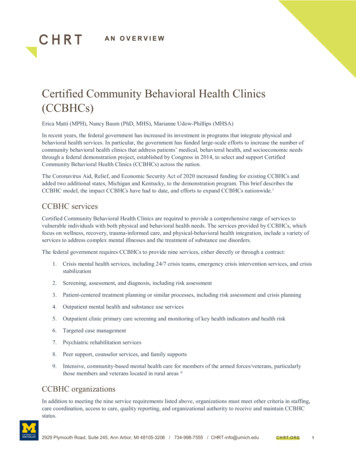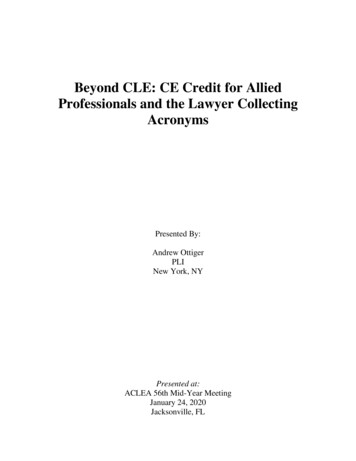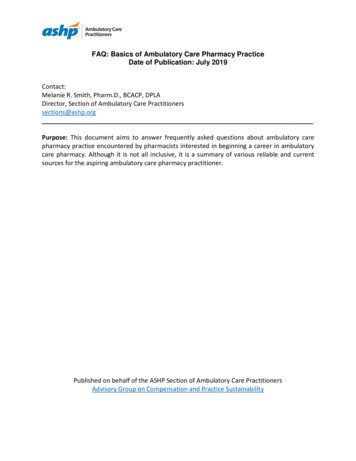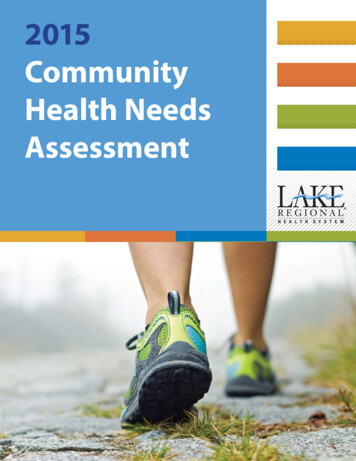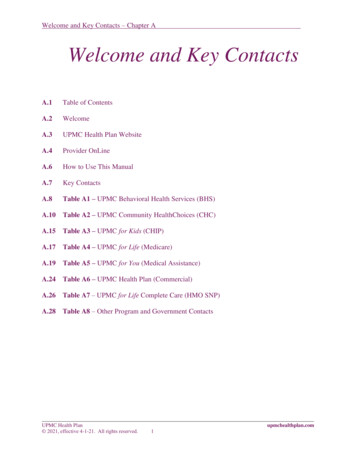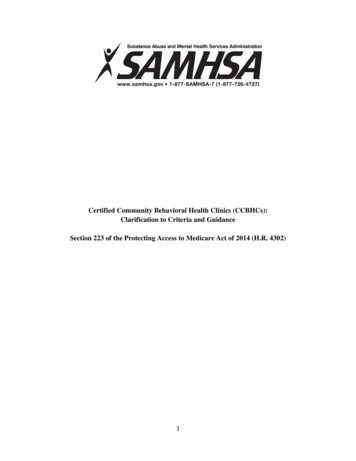
Transcription
Certified Community Behavioral Health Clinics (CCBHCs):Clarification to Criteria and GuidanceSection 223 of the Protecting Access to Medicare Act of 2014 (H.R. 4302)1
Table of ContentsProgram Requirement 1: Staffing . 3Program Requirement 2: Availability and Accessibility of Services. 4Program Requirement 3: Care Coordination . 7Program Requirement 4: Scope of Services . 10Program Requirement 5: Quality and Other Reporting . 20Program Requirement 6: Organizational Authority, Governance and Accreditation . 20General Questions and Clarifications . 212
Clarifications on Questions from States During the CCBHC Planning Grant PeriodProgram Requirement 1: StaffingQuestion 1-1: If a CCBHC is required by a state’s law to be accredited by a state-approvedaccrediting body (e.g. TJC, CARF, or ACHC), could the staffing plan simply state thatthe CCBHC must be in compliance with the accrediting body’s staffing standards? SinceSAMHSA is encouraging accreditation and if a state mandates it, it seems overlybureaucratic to add another layer of requirements.Clarification 1-1: See Criteria 1.a and 1.b.2. The staffing plan is influenced by many factorsincluding the needs assessment, services to veterans, and other state-determined criteria.States are responsible to certify that clinics meet the Criteria specific to CCBHCs.Question 1-2: Clinics have questions about the licensure requirement. Are all clinicians requiredto have or to be in pursuit of their license? With the BH provider shortage, can a clinic belicensed and individuals who are supervised by a licensed clinician count?Clarification 1-2: Please refer to the complete Criterion 1.b.2, Licensure and Credentialing ofProviders. It reads in part, “The CCBHC staffing plan meets the requirements of thestate behavioral health authority and any accreditation standards required by the state, isinformed by the state’s initial needs assessment, and includes clinical and peer staff TheCCBHC must have staff, either employed or available through formal arrangements, whoare credentialed substance abuse specialists CCBHCs are not precluded by anything inthis criterion from utilizing providers working toward licensure, provided they areworking under the requisite supervision.”Question 1-3: When developing services to be included in the CCBHC that are not alreadycovered by the state plan, is it also allowable to look at alternative provider types that arenot currently covered under the state plan? An example would be Community HealthWorkers. (Question is about which state providers can render demonstration services.)Clarification 1-3: The state may contract with providers not covered by the Medicaid State Planin order to meet the requirements of the Criteria. Refer to the Criterion 1.b.2, to ensurethat providers meet the necessary requirements.Question 1-4: Can you provide clarification between a contractor/subcontractor and a DCO, andwhat (if any) distinction lies between them?Clarification 1-4: DCOs are not under the direct supervision of the CCBHC while contract staffmembers are under direct supervision of the CCBHC.Please see the Criteria which include this definition of a “Designated CollaboratingOrganization (DCO): A DCO is an entity that is not under the direct supervision of theCCBHC but is engaged in a formal relationship with the CCBHC and delivers servicesunder the same requirements as the CCBHC. Payment for DCO services is includedwithin the scope of the CCBHC PPS, and DCO encounters will be treated as CCBHCencounters for purposes of the PPS. The CCBHC maintains clinical responsibility for theservices provided for CCBHC consumers by the DCO. To the extent that services are3
required that cannot be provided either by the CCBHC directly or by a DCO, referralsmay be made to other providers or entities. The CCBHC retains responsibility for carecoordination including services to which it refers consumes. Payment for those referredservices is not through the PPS but is made through traditional mechanisms withinMedicaid.”See Criterion 1.b.2 which reads in part, “The CCBHC staffing plan meets therequirements of the state behavioral health authority and any accreditation standardsrequired by the state, is informed by the state’s initial needs assessment, and includesclinical and peer staff. In accordance with the staffing plan, the CCBHC maintains a corestaff comprised of employed, and, as needed, contracted staff, as appropriate to the needsof CCBHC consumers as stated in consumers’ individual treatment plans and as requiredby program requirements 3 and 4 of these Criteria ”Program Requirement 2: Availability and Accessibility of ServicesQuestion 2-1: Is it a requirement that a CCBHC provide evening and weekend hours at all of theoffices of the CCBHC or can this be limited to the CCBHC’s larger locations?Clarification 2-1: Please refer to Criterion 2.a.2, “The CCBHC provides outpatient clinicalservices during times that ensure accessibility and meet the needs of the consumerpopulation to be served, including some nights and weekend hours.” Needs assessmentsshould evaluate accessibility and availability for all individuals – including those servedas well as those who are under-served and unserved. States have discretion aboutCCBHC locations and operating hours based on the needs of all individuals.Question 2-2: Can clarity be provided with regards to specific services which can be provided incompliance with the “non-four walls” requirement of the CCBHC? Are visits toincarcerated clients, visits with clients at places such as restaurants allowed? If the siteisn’t licensed, is the service billable?Clarification 2-2: The state has the flexibility to determine which of the nine required servicesmay be provided outside the four walls. See Criterion 2.a.5, “To the extent possiblewithin the state Medicaid program and as allowed by state law, CCBHCs utilize mobilein-home, telehealth/telemedicine, and on-line treatment services to ensure consumershave access to all required services.” Services to individuals within incarcerationfacilities are not covered. Clinics must meet state licensure requirements and must be“certified” CCBHCs in order to bill for services. Discretion should be exercised whenmeeting consumers outside the four walls including in restaurants to maintainconfidentiality, safety, accountability, and professionalism.Question 2-3: For a new assessment on a client at a CCBHC, is it allowable to both scheduleclients and allow walk-in availability for clients?Clarification 2-3: Yes, as long as services comply with the certification Criteria. See Criteria2.B. regarding timely access to services and initial and comprehensive evaluations.Question 2-4: We are looking for guidance on the screening assessment and treatment planningrequirements for consumers who are already receiving services from the CCBHC at the4
time of certification. Can the state establish criteria for acceptable screening, etc. thatwere done within a certain time period prior to CCBHC certification? Can the stateestablish a phase-in period for CCBHCs to renew and update all assessments andtreatment planning base on CCBHC Criteria?Clarification 2-4: See Criterion 2.b.2, “The comprehensive person-centered and family-centereddiagnostic and treatment planning evaluation is updated by the treatment team, inagreement with and endorsed by the consumer and in consultation with the primary careprovider (if any), when changes in the consumer’s status, responses to treatment, or goalachievement have occurred. The assessment must be updated no less frequently thanevery 90 days unless the state has established a standard that meets the expectations ofquality care and that renders this time frame unworkable; or state, federal, or applicableaccreditation standards are more stringent.” We interpret this Criterion to mean that allexisting CCBHC consumers will have a comprehensive review and update of theirtreatment plans within 90 days of the first day of CCBHC service implementation.Question 2-5: Do states have flexibility in implementing the requirement that consumers andfamilies have 24/7 access to mobile crisis services? Must clinicians be on site 24/7? May clinicians be on call and not on site 24/7? May law enforcement be the first point of contact, directing consumers toclinicians and/or consulting with clinicians as appropriate and needed? May law enforcement be considered members of the mobile crisis team? What role may local EDs, hotlines and warm-lines play in mobile crisisservices?Clarification 2-5: CCBHCs must provide robust and timely crisis behavioral health servicesincluding 24-hour mobile crisis teams, emergency crisis intervention services, and crisisstabilization as required in statute and codified in CCBHC Criteria. The provision ofthese crisis behavioral health services directly by the CCBHC or through an existingstate-sanctioned, certified, or licensed system or network, cannot be waived.Police departments do not represent an existing state-sanctioned, certified, or licensedsystem or network for the provision of crisis behavioral health services. Reliance onpolice does not constitute a robust crisis behavioral health service.States are responsible to clearly define 24-hour mobile crisis teams, emergency crisisintervention services, and crisis stabilization in their certification process. These servicesmust include suicide crisis response and services capable of addressing crises related tosubstance abuse and intoxication, including ambulatory and medical detoxification.There are several Criteria that affect this requirement and need to be considered as thestate defines and applies the terms. The Criteria below underscore the importance ofproviding a coordinated response to behavioral health crises that promote individualrecovery, reduced trauma, and lowered cost of care:2 - Because the emergency department (ED) is often a source of crisis care, CCBHCsmust have clearly established relationships with local EDs to facilitate care coordination,5
discharge and follow-up, as well as relationships with other sources of crisis care (see3.c.5 in the Care Coordination section below).2.c.2 - The methods for providing a continuum of crisis prevention, response, and postvention services are clearly described in the policies and procedures of the CCBHC andare available to the public.2.c.3 - Individuals who are served by the CCBHC are educated about crisis managementservices such as and Psychiatric Advanced Directives and how to access crisis services,including suicide or crisis hotlines and warm-lines, at the time of the initial evaluation.This includes individuals with limited English proficiencies or disabilities (i.e., CCBHCprovides instructions on how to access services in the appropriate methods, language(s),and literacy levels in accordance with program requirement 1).2.c.4 - Protocols are established for CCBHC staff to address the needs of CCBHCconsumers in psychiatric crisis who come to those EDs.2.c.5 - Protocols for the involvement of law enforcement are in place to reduce delays forinitiating services during and following a psychiatric crisis.2.c.6 - Following a psychiatric emergency or crisis involving a CCBHC consumer, inconjunction with the consumer, the CCBHC creates, maintains, and follows a crisis planto prevent and de-escalate future crisis situations with the goal of preventing future crisesfor the consumer and their family.There may be other ways that clinics can provide 24-hour coverage that do not includereliance on police. The clinic may wish to consult the state to develop a solution thatwould comply with the criteria. SAMHSA staff members are available to consult withstates on appropriate options.Question 2-6: Our agencies who are eligible for CCBHC certification serve a number of countiesor catchment areas. Knowing that the CCBHC is required to provide services to anyperson seeking BH services, does that apply to clients living outside the catchment area?Clarification 2-6: See Criteria 2.e.1 and 2.e.2. See clarification to next question.Question 2-7: For CCBHCs in areas that border other states, does the CCBHC have to provideservices for out of state clients? Does the CCHBC have to provide only emergencyservices for out of state patients?Clarification 2-7: See Criteria 2.e.1 and 2.e.2. CCBHCs must have protocols addressing theneeds of consumers who do not live close to a CCBHC or within the CCBHC servicearea as determined by the state. CCBHCs are responsible for providing, at a minimum,crisis response, evaluation, and stabilization services regardless of place or residence. Therequired protocols should address management of the individual’s ongoing treatmentneeds beyond that. Protocols may provide for agreements with clinics in other localities,allowing CCBHCs to refer and track consumers seeking non-crisis services to theCCBHC or other clinic serving the consumer’s county of residence. For distantconsumers within the CCBHC’s service area, CCBHCs should consider use of6
telehealth/telemedicine to the extent practicable. In no circumstances (and in accordancewith PAMA § 223 (a)(2)(B)), may any consumer be refused services because of place ofresidence.Question 2-8: Mobile Crisis 24/7 is one of the required four core CCBHC services that aCCBHC must provide directly. If the CCBHC does not currently have an establishedcatchment area, and based on the requirement that a CCBHC cannot turn away anyonedue to location or ability to pay, how will that affect the provision of services in a largegeographical area? Would the CCBHC need to identify a catchment area? If they do,what is the distance then identified that would be outside of the catchment area?To expand on the question above, if a CCBHC provides many community-based services(outside the four walls) and does not have an identified catchment area, would acatchment area need to be identified? If not, how would a CCBHC comply with seeingany consumer regardless of residence and ability to pay, given such a large geographicallocation?Clarification 2-8: The Criteria require the state to conduct a community needs assessment foreach CCBHC. The service area (we are using that term instead of catchment area) mustbe defined by the state in order to determine the “community” to be served by theCCBHC. The CCBHC’s staffing plan, EBPs, cultural and linguistic capabilities, andservice hours should be established based on the population residing within that servicearea.This will also help when CCBHCs develop “protocols addressing the needs of consumerswho do not live close to a CCBHC or within the CCBHC catchment area as establishedby the state.” See Criterion 2.e.2 for details.Program Requirement 3: Care CoordinationQuestion 3-1: The CCBHC is required to treat anyone who requests and needs service. Howshould the CCBHC handle care coordination in a situation in which someone comes infor a primary substance abuse service but refuses to sign consent to the release ofinformation?Clarification 3-1: Please see Criterion 3.a.2 which requires “Necessary consent for release ofinformation is obtained from CCBHC consumers for all care coordination relationships.If CCBHCs are unable, after reasonable attempts, to obtain consent for any carecoordination activity specified in program requirement 3, such attempts must bedocumented and revisited periodically.”Question 3-2: Do states have flexibility in implementing the requirement that consumers andfamilies have 24/7 access to mobile crisis services? Must clinicians be on site 24/7? May clinicians be on call and not on site 24/7? May law enforcement be the first point of contact, directing consumers toclinicians and/or consulting with clinicians as appropriate and needed? May law enforcement be considered members of the mobile crisis team?7
What role may local EDs, hotlines and warm-lines play in mobile crisisservices?Clarification 3-2: CCBHCs must provide robust and timely crisis behavioral health servicesincluding 24-hour mobile crisis teams, emergency crisis intervention services, and crisisstabilization as required in statute and codified in CCBHC Criteria. The provision ofthese crisis behavioral health services directly by the CCBHC or through an existingstate-sanctioned, certified, or licensed system or network, cannot be waived.Police departments do not represent an existing state-sanctioned, certified, or licensedsystem or network for the provision of crisis behavioral health services. Reliance onpolice does not constitute a robust crisis behavioral health service.States are responsible to clearly define 24-hour mobile crisis teams, emergency crisisintervention services, and crisis stabilization in their certification process. These servicesmust include suicide crisis response and services capable of addressing crises related tosubstance abuse and intoxication, including ambulatory and medical detoxification.There are several Criteria that affect this requirement and need to be considered as thestate defines and applies the terms. The Criteria below underscore the importance ofproviding a coordinated response to behavioral health crises that promote individualrecovery, reduced trauma, and lowered cost of care. (See Q2- and C2- above onavailability and accessibility of services for additional Criteria which are pertinent to theclarification for this question.)3.a.4 - CCBHCs develop a crisis plan with each consumer so as to ascertain in advancethe consumer’s preferences in the event of psychiatric or substance use crisis. Examplesof crisis plans may include a Psychiatric Advanced Directive or Wellness RecoveryAction Plan.3.c.3 - CCBHCs must have agreements with suicide/crisis hotlines and warm-lines.3.c.5 - The CCBHC has an agreement establishing care coordination expectations withinpatient acute-care hospitals, including EDs, hospital outpatient clinics, urgent carecenters, residential crisis settings, medical detoxification inpatient facilities andambulatory detoxification providers, in the area served by the CCBHC, to address theneeds of CCBHC consumers. This includes procedures and services, such as peerbridgers, to help transition individuals from the ED or hospital to CCBHC care andshortened time lag between assessment and treatment. The agreement is such that theCCBHC can track when their consumers are admitted to facilities providing the serviceslisted above, as well as when they are discharged, unless there is a formal transfer of careto another entity. The agreement also provides for transfer of medical records of servicesreceived (e.g., prescriptions) and active follow-up after discharge.There may be other ways that clinics can provide 24-hour coverage that do not includereliance on police. The clinic may wish to consult the state to develop a solution thatwould comply with the criteria. SAMHSA staff members are available to consult withstates on appropriate options.8
Question 3-3: Must DCOs purchase an EHR or change their electronic system to be the same asthe CCBHC’s? Do they need a HIE?Clarification 3-3: The Criteria require that the CCBHC have an EHR but there is no requirementthat a DCO have one at the time of certification. However, the CCBHC must develop aplan over the two-year demonstration program. See Criterion 3.b.5, “ the CCBHC willdevelop a plan to be produced within the two-year demonstration program time frame tofocus on ways to improve care coordination between the CCBHCs and all DCOs using ahealth IT system ”Question 3-4: If a state has multiple schools and multiple school districts within one CCBHCcatchment area, must the CCBHC complete formal agreements with all schools or schooldistricts?Clarification 3-4: We suggest that you prioritize some, referring to your needs assessment todetermine relative priority. After completing formal agreements with the most criticalschool districts or schools, during the demonstration period the CCBHC should work onincreasing the number of agreements. The state may be able to help CCBHCs by askingthe State Department of Education to inform school districts about the importance ofthese working relationships and agreements. See the Criteria in 3.C which address carecoordination agreements and contingency plans when those cannot be established withinthe time frame of the demonstration period.Question 3-5: Do CCBHCs need contracts with FQHCs or just agreements?Clarification 3-5: Criterion 3.c.1 is specific to FQHCs and allows an agreement initially. 3. c.1goes on to say that “CCBHCs are expected to work toward formal contracts with entitieswith which they coordinate care if they are not established at the beginning of thedemonstration project.”The purpose of the initial agreement – and the contract that follows – is spelled out inCriteria 3.c.1 through 3.c.5, to address the underlying reasons and some instances inwhich agreements or contracts are required, the types of entities with which CCBHCsshould have agreements or contracts, and some content requirement for agreements andcontracts.Question 3-6: In regards to CCBHC service requirement 3.c.2, a CCBHC must provide carecoordination for consumers who need ambulatory detox. Our state has no category forambulatory detox. Our current regulations/rules do not allow for off-site outpatient detox,so there would be no available programs to refer consumers to. Due to this issue, isambulatory detox used as an example of a level of care, or is that a specific level of carethat the state would need to ensure is in place? Currently the detox services the statelicenses/certifies are residential in nature.Clarification 3-6: Please review the definitions posted at Substance Use Disorder TreatmentProviders and CCBHCs on the SAMHA Section 223 website.Question 3-7: Criterion 3.c.4 requires CCBHCs to have an agreement establishing carecoordination expectations with the nearest Department of Veterans’ Affairs medical9
center, independent clinic, drop-in center, or other facility of the Department. The nearestVA facility for many parts of our state is in a border state. How will this impact thestate’s demonstration program, and what should the state require from CCBHCs, relatedto requirements to provide services to veterans?Clarification 3-7: Please refer to Criterion 4.k.1 describing the requirements of the CCBHC todeliver services to veterans. There is nothing in the Criteria to prevent the CCBHC fromreferring consumers who are veterans to the closest VA facility if it is located in adifferent state. (Question and Clarification are repeated in Scope of Services sectionbelow.)Program Requirement 4: Scope of ServicesQuestion 4-1: Are DCOs able to contract with multiple CCBHCs?Clarification 4-1: There is nothing in the criteria to prohibit a DCO from contracting with morethan one CCBHC.Question 4-2: Would a CCBHC still meet SAMHSA’s requirement of being “clinicallyresponsible” for provision of services rendered by DCOs if the CCBHC contractuallyrequired the DCO to 1) indemnify the CCBHC against malpractice liability for CCHBCservices furnished by the DCO, and 2) add the CCBHC as an insured on the DCO’smedical malpractice insurance policy?Clarification 4-2: Yes, both would be permissible.Question 4-3: Would the CCBHC still meet SAMHSA’s requirement of being “clinicallyresponsible” for the provision of services rendered by the DCOs if the DCO’s cliniciansmaintained charts in the DCO’s own separate health record, then shared informationappropriately with the CCBHC? Or are the CCBHC and DCO required to maintain chartsin the same health record?Clarification 4-3: The CCBHC and DCO are not required to maintain charts in the same healthrecord. CCBHCs are responsible for the treatment planning. CCBHC records must reflectthat services are being rendered in compliance with the treatment plan. The CCBHCrecord must reflect a complete and accurate depiction of services for which the CCBHCis responsible for overseeing including services provided by a DCO.Question 4-4: Can you please provide some clarity regarding how states are able to comply withthe Corporate Practice of Medicine rules as it relates to Criterion 4.a.1 that states that“the CCBHC is ultimately clinically responsible for all care provided. The decision as tothe scope of services to be provided directly by the CCBHC, as determined by the stateand clinics as part of certification, reflects the CCBHC’s responsibility and accountabilityfor the clinical care of the consumers.” There is some confusion regarding how areCCBHCs that do not provide primary care services, but rather contract with the DCO forthe primary care services can be ultimately clinically responsible for all care provided,giving the limits set by the corporate practice of medicine rules.10
Clarification 4-4: CCBHCs are responsible for outpatient clinic primary care screening andmonitoring of key health indicators and health risk as well as care coordination withprimary care providers. They are not responsible for the provision of primary care.Question 4-5: We understand that the four core services must be provided by the CCBHC. Mustthe other five required services be provided by the CCBHC or by a DCO, or could someof these five required services be provided by another provider under contract to theCCBHC?Clarification 4-5: The four core services must be provided by the CCBHC. Please see Criteria4.c.1, 4.d.1, 4.e.1, and 4.f.1 for the four core services to be provided directly by theCCBHC. The other five required services are listed in Program Requirement 4 of theCriteria and must be provided either by the CCBHC or by a DCO. Please see Criterion4.a.2, “The CCBHC ensures all CCBHC services, if not available directly through theCCBHC, are provided through a DCO, consistent with the consumer’s freedom to chooseproviders within the CCBHC and its DCOs.”Question 4-6: Guidance on the SAMHSA website indicates that CCBHCs are required to providefour levels of detoxification services and specifies how they are to be provided - level 1directly; that it is preferred for CCBHCs to provide level 2 directly; that levels 3.2 and3.7 should be provided directly, by a DCO or via a referral. Criterion 4.c.1 indicates onlythat the CCBHC ensure that detoxification services are available within the CCBHCstructure, which can be defined by the state. If a state does not license one of the fourlevels of detoxification services, so that one of the levels is not available in the state, willthat service be required to be provided by a CCBHC?Clarification 4-6: CCBHCs are required to provide the first four of five withdrawal managementservices for adults, and those services must be available and readily accessible as part ofCCBHCs’ crisis services. These four services are levels 1, 2, 3.2, and 3.7. Visit SubstanceUse Disorder Treatment Providers and CCBHCs on the SAMHSA 223 website, whichincludes a link to the American Society of Addiction Medicine, where these fourambulatory and medical detoxification services are defined: 1-WM: Mild withdrawal with daily or less than daily outpatient supervision;likely to complete withdrawal management and to continue treatment or recovery.The CCBHC must directly provide 1-WM.2-WM: Moderate withdrawal with all-day withdrawal management support andsupervision; at night, has supportive family or living situation, likely to completewithdrawal management. The CCBHC is encouraged to directly provide 2-WM.While the CCBHC must have the 2-WM level of ambulatory withdrawalmanagement available and accessible to eligible consumers, it is not arequirement that this service be provided directly, although it is encouraged.3.2-WM: Moderate withdrawal, but needs 24-hour support to completewithdrawal management and increase likelihood of continuing treatment or11
recovery. May be provided directly either by the CCBHC or through a DCOrelationship or by referral.3.7-WM: Severe withdrawal and needs 24-hour nursing care and physician visitsas necessary; unlikely to complete withdrawal management without medical, ornursing monitoring. May be provided directly either by the CCBHC or through aDCO relationship or by referral.See also the CCBHC Criteria Checklist of the “Guidance to Planning Grant States toApply to Participate in the Section 223 CCBHC Demonstration Program. On pages 34and 35 of the Checklist, Criteria 4.C, Crisis Behavioral Health Services, the state mustrate the clinic on the following criteria: “The following services are explicitly includedamong CCBHC services that are provided directly or through an existing statesanctioned, certified, or licensed system or network for the provision of crisis behavioralhealth services: (1) 24 hour mobile crisis teams, (2) emergency crisis interventionservices, (3) crisis stabilization services, (4) suicide crisis response, and (5) services forsubstance abuse crisis and intoxication, including ambulatory and medical detoxificationservices.” If the CCBHC is unable to provide one of four levels of detoxification servicesdirectly, through a DCO, or by referral, even if the state does not license these services,you must rate the clinic accordingly and provide justification at the end of the programrequirement checklist. States may use the narrative justification to explain deficiencies inservices and how they will be addressed. The demonstration program intends to moveservices and treatment to
system or network for the provision of crisis behavioral health services. Reliance on police does not constitute a robust crisis behavioral health service. States are responsible to clearly define 24-hour mobile crisis teams, emergency crisis intervention services, and crisis stabilization in their certification process. These services
